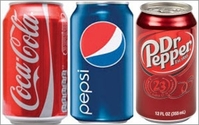
The three largest soda companies are cooperating in a pledge to reduce the average beverage calories consumed per person in the U.S. by 20% by 2025.
In an announcement during the Clinton Global Initiative conference in New York City, Coca-Cola, PepsiCo and Dr Pepper Snapple Group said that they'll employ marketing, packaging and
distribution to increase consumers' acceptance of smaller portions of regular soda, and their interest in consuming water and no- and lower-calorie beverages.
They also said
they will provide calorie counts, and promote calorie awareness, on their vending machines, self-serve dispensers and retail coolers nationwide.
On the local level, they pledged to
focus their efforts in communities where there has been less interest in and/or access to lower-calorie options, starting with Los Angeles and Little Rock, Ark. Local efforts will include promoting
water and no- and lower-calorie beverage consumption through merchandising, product placement, couponing and other tactics.
advertisement
advertisement
The beverage companies and the American Beverage
Association (ABA) are working with the Alliance for a Healthier Generation, which was founded by former President Bill Clinton's Clinton Foundation and the American Heart Association to fight
childhood obesity.
The parties said that the initiative's progress will be assessed at intervals, by independent researchers.
Of course, the big soda
companies have already been responding to declining carbonated soft drink (CSD) volumes by marketing smaller-size portions of regular-calorie sodas, in particular -- a strategy that has not only
proven to be popular with consumers, but has helped bolster the bottom line by enabling the companies to charge more per ounce and realize larger margins. They have also for some time been investing
more in marketing, developing and acquiring alternative beverages, including water and flavored waters, teas and energy drinks.
Furthermore, they were already pushing hard to
revive sales of diet sodas (Diet Coke is launching a new campaign Sept. 24), and
struggling to find new, "natural" no- and low-cal sweeteners for sodas and other beverages that will be embraced by consumers (as evidenced, for example, by the recent flap over Vitaminwater's disastrous change of its formula).
Michael Jacobson, executive director of the Center for Science in the Public Interest (CSPI), issued a statement saying that the pledge was good news, and applauding Clinton's
efforts.
However, he also pointed out that soda volumes and calorie consumption have been in decline for years. (Total U.S. carbonated soft drink volumes were down 3% last
year, and total calories consumed from sugary beverages declined by 12% 2000 and 2013, according to Beverage Digest.) He added that regulations required by the Affordable Care Act will soon require
calorie labeling on the vast majority of vending machines nationwide in any case, and asserted that the soda companies could accelerate progress by dropping their opposition to taxes and
calorie/obesity warning labels on sugary drinks.
The ABA and its members have spent millions fighting soda taxes (including $800,00 to date to defeat a soda tax proposal that will be on the ballot in Berkeley,
Calif. on Nov. 4), warning labels on soda, and other soda-focused initiatives, like New York City's failed attempt to limit the sale of large-size portions of sugary drinks.
On the
other hand, they have also implemented voluntary efforts to address soda-related obesity concerns.
Notably, in 2006, working with the Alliance for a Healthier Generation, ABA agreed
to stop shipping regular sodas to schools. Over three school years, this achieved an 88%
reduction in total beverage calories shipped to schools. (This initiative preceded the mandatory removal of sugar-added drinks from schools that was finally implemented this year, based on
requirements that were part of the Healthy, Hunger Free Kids Act passed in 2010 -- although CSPI maintains the initiative was in direct response to its threat to sue the soda industry.)
In addition, ABA worked with the cities of Chicago and San Antonio to offer lower-calorie options in public building vending machines, noted The New York Times.